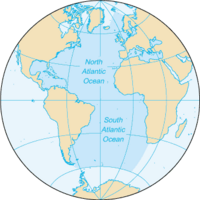
Photo from wikipedia
In the coming decades, environmental change like warming and acidification will affect life in the ocean. While data on single stressor effects on fish are accumulating rapidly, we still know… Click to show full abstract
In the coming decades, environmental change like warming and acidification will affect life in the ocean. While data on single stressor effects on fish are accumulating rapidly, we still know relatively little about interactive effects of multiple drivers. Of particular concern in this context are the early life stages of fish, for which direct effects of increased CO2 on growth and development have been observed. Whether these effects are further modified by elevated temperature was investigated here for the larvae of Atlantic herring (Clupea harengus), a commercially important fish species. Over a period of 32 days, larval survival, growth in size and weight, and instantaneous growth rate were assessed in a crossed experimental design of two temperatures (10°C and 12°C) with two CO2 levels (400 μatm and 900 μatm CO2) at food levels mimicking natural levels using natural prey. Elevated temperature alone led to increased swimming activity, as well as decreased survival and instantaneous growth rate (Gi). The comparatively high sensitivity to elevated temperature in this study may have been influenced by low food levels offered to the larvae. Larval size, Gi and swimming activity were not affected by CO2, indicating tolerance of this species to projected "end of the century" CO2 levels. A synergistic effect of elevated temperature and CO2 was found for larval weight, where no effect of elevated CO2 concentrations was detected in the 12°C treatment, but a negative CO2 effect was found in the 10°C treatment. Contrasting CO2 effects were found for survival between the two temperatures. Under ambient CO2 conditions survival was increased at 12°C compared to 10°C. In general, CO2 effects were minor and considered negligible compared to the effect of temperature under these mimicked natural food conditions. These findings emphasize the need to include biotic factors such as energy supply via prey availability in future studies on interactive effects of multiple stressors.
Journal Title: PLoS ONE
Year Published: 2018
Link to full text (if available)
Share on Social Media: Sign Up to like & get
recommendations!